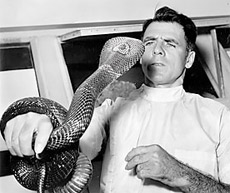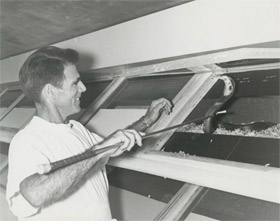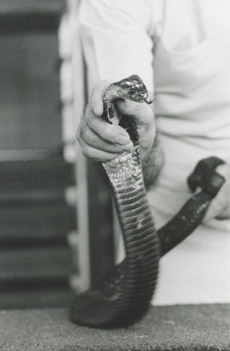
The uniqueness of Bill Haast has been described here and elsewhere, but no characteristic is more mesmerizing and fascinating than his ability to handle venomous reptiles. He was unquestionably the maestro; each snake was captured with such skill and finesse that in it's witnessing the viewer was left with a sense of awe that comes from knowing they were in the presence of a great master, for the delicate battle of reflexes was actually a ballet, a duel of sorts, it was just extraordinary.
It might be thought that his handling skills were honed over time with repetition, but perhaps as is true of most great masters, whether in art or music, architecture or fashion, genius and certain skills are inborn. And Bill's talent to know the animal so intimately as to be able to predict it's movements, it's intentions, it's limitations and to never (or try to never) underestimate it's quickness, sharp attention, and physical abilities was innate in Bill, like his intuitive nature in other ways. Coupled with intense admiration for one of nature's most amazing animals, those catches were the ultimate challenge to himself; he enjoyed the dance. And as always, no matter what the activity, it had to be purposeful. Wasted time or wasted effort was abhorrent.

One other question often asked, is why not the use of some sort of safety gear in the way of gloves, etc.to be used as protection. The answer has to do with the delicacy with which snakes needed to be handled and make no question about it, lethal venom or not, venomous snakes are very, very delicate. They are instinctive, defensive and reactive, with no way to know that anything Bill was doing was for their benefit. They just tried with all their might to survive an encounter with an animal so much larger than themselves, and after being captured, no matter how gently, would twist trying to reach Bill's hand, contort their bodies in an attempt to escape, and could easily hurt themselves in the process. It was absolutely critical that Bill be able to feel them; he needed that delicate touch to keep them safe from themselves. A great deal of finesse was required, especially with cobras * and trying to catch them with heavy leather (double thickness moosehide would be the only truly snakebite proof material for the larger vipers) would be like playing a Stradivarius violin or Steinway piano with thick gloves, it just wouldn't work.

Photo by Patricia Caufield
* cobras have elongated ribs than fan out to form the "hood" with which the snake tries to look larger to it's enemy in an attempt to scare it off. Those extended ribs if not caught very gently, could easily puncture the fine skin that covered them. Bill had to judge when to actually make the "catch", and simultaneously do it in such a way to allow the ribs to lay down flat against the snake's ribcage in the process. It was impractical to pin cobras down with a snake hook, for their scales were shiny and afforded little traction against the metal hook, even when it was wrapped in rubber. The snake was still slick below, and since it was always attempting to rise up, battling it to the catching mat was not a method Bill considered to be in the best interest of himself or the snake.

Bill catching a monacled cobra